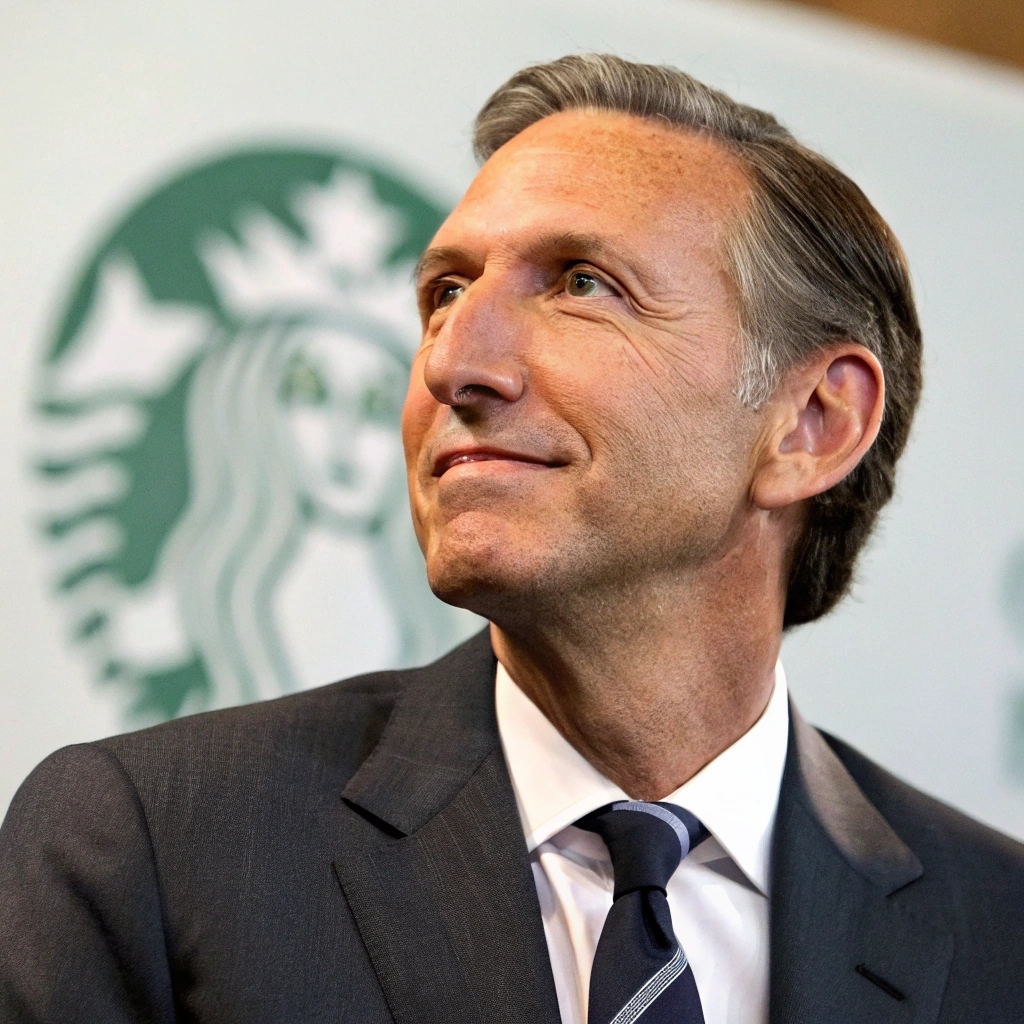Your cart is currently empty!

The Inspiring Journey of Howard Schultz: The CEO Who Built Starbucks into a Global Empire
Starbucks is one of the most recognizable coffee brands in the world, with thousands of stores in more than 80 countries. But behind this success is Howard Schultz, the man who transformed a small Seattle coffee shop into a global empire.
Starbucks is one of the most recognizable coffee brands in the world, with thousands of stores in more than 80 countries. But behind this success is Howard Schultz, the man who transformed a small Seattle coffee shop into a global empire. His story is one of resilience, vision, and determination. From humble beginnings to becoming the CEO of Starbucks, Schultz’s journey is filled with valuable lessons for aspiring entrepreneurs.
Early Life and Humble Beginnings
Howard Schultz was born on July 19, 1953, in Brooklyn, New York. He grew up in a poor neighborhood in a housing project for low-income families. His father, a truck driver, struggled with job security and was injured on the job, leaving the family in financial hardship.
Schultz often recalls this period as a defining moment in his life, shaping his views on economic opportunity and business ethics. He knew from a young age that he wanted to break free from the cycle of poverty and build a better future for himself.
Despite financial struggles, Schultz excelled in sports, especially basketball, which helped him earn an athletic scholarship to Northern Michigan University. He was the first in his family to attend college, where he majored in communications.
After graduating, he took various sales jobs before landing a position at Hammarplast, a Swedish company that sold kitchenware, including coffee makers. This job would change his life forever.
Discovering Starbucks: A Life-Changing Moment
While working at Hammarplast in the early 1980s, Schultz noticed that a small Seattle-based coffee company called Starbucks was placing unusually large orders for coffee makers. Intrigued, he traveled to Seattle to see what was special about this company.
At the time, Starbucks was a small coffee roastery with only a few stores, founded in 1971 by Jerry Baldwin, Gordon Bowker, and Zev Siegl. They sold high-quality coffee beans but did not serve brewed coffee.
Schultz saw huge potential in Starbucks. He believed that the company could expand beyond just selling coffee beans and introduce a European-style coffee experience to the U.S. However, the founders were not interested in growing the business that way.
Despite this, Schultz was so convinced of Starbucks’ potential that he left his well-paying job to join the company in 1982 as Director of Marketing.
A Vision for Starbucks: The Italian Inspiration
In 1983, Schultz traveled to Milan, Italy, and had a life-changing experience. He saw how Italians gathered in espresso bars, enjoying coffee as part of their daily culture. These coffee shops were not just places to grab a drink—they were community hubs where people socialized.
Schultz envisioned bringing this experience to America. He wanted Starbucks to be more than a coffee retailer; he saw the opportunity to create a “third place” between work and home—a space where people could relax, connect, and enjoy quality coffee.
Excited by this vision, Schultz returned to Seattle and pitched the idea to Starbucks’ founders. But they rejected it, believing that Starbucks should remain a coffee bean retailer.
Undeterred, Schultz decided to leave Starbucks and start his own coffee company to bring his vision to life.
Building His Own Coffee Business
In 1985, Schultz started Il Giornale, an espresso bar inspired by Italian coffee culture. He struggled to raise funds, pitching his idea to over 200 investors, many of whom rejected him, saying that Americans would never pay $3 for a cup of coffee.
Despite the challenges, he eventually secured funding and opened his first Il Giornale store in Seattle in 1986. The concept was a success, attracting loyal customers who loved the premium coffee experience.
A year later, in 1987, the original Starbucks founders decided to sell the company, and Schultz saw this as his opportunity. He raised $3.8 million to buy Starbucks and merged it with Il Giornale.
From that moment, Schultz became the CEO of Starbucks, and his real journey began.
Expanding Starbucks into a Global Empire
Once in control of Starbucks, Schultz aggressively expanded the company. He introduced several key strategies that turned Starbucks into a global powerhouse:
- Creating the Starbucks Experience – Schultz focused on making Starbucks a welcoming place, not just a coffee shop. He emphasized customer service, comfortable seating, and premium coffee.
- Rapid Expansion – Under Schultz, Starbucks grew rapidly, opening stores across the U.S. and eventually around the world. By the mid-1990s, Starbucks had become a household name.
- Employee-Centric Culture – Remembering his father’s struggles, Schultz ensured that Starbucks employees (called “partners”) received health benefits, stock options, and fair wages—even part-time workers.
- Innovation and Menu Expansion – Starbucks introduced new products, such as Frappuccinos, seasonal drinks, and food options, to attract a broader customer base.
By the late 1990s, Starbucks was a publicly traded company and had thousands of stores worldwide.
Challenges and Leadership Comebacks
Despite Starbucks’ massive success, the company faced challenges in the 2000s. Schultz stepped down as CEO in 2000 but returned in 2008 when Starbucks began to struggle due to the financial crisis and overexpansion.
Upon his return, he closed underperforming stores, refocused on customer experience, and introduced new digital initiatives, such as mobile payments and loyalty rewards. His leadership helped Starbucks recover and grow stronger than ever.
Howard Schultz’s Legacy and Impact
Howard Schultz stepped down as CEO in 2017 but left behind an incredible legacy. Under his leadership, Starbucks became:
✅ A globally recognized brand
✅ A pioneer in employee benefits for part-time workers
✅ A leader in ethical sourcing and sustainability
✅ A company with a strong social mission
Schultz has also used his success to advocate for social causes, including veterans’ employment, education, and racial equality.
Lessons from Howard Schultz’s Success
Entrepreneurs can learn many valuable lessons from Howard Schultz’s journey:
1. Believe in Your Vision
Even when others doubted him, Schultz believed in his idea and pursued it relentlessly.
2. Overcome Rejection
Schultz was rejected by over 200 investors but never gave up. Persistence is key to success.
3. Focus on Customer Experience
Starbucks became a success not just because of coffee, but because of the experience it provided to customers.
4. Take Care of Your Employees
By offering fair wages and benefits, Schultz built a loyal workforce that contributed to Starbucks’ success.
5. Adapt and Innovate
Even during hard times, Schultz adapted, innovated, and helped Starbucks bounce back.
Final Thoughts
Howard Schultz’s story is a powerful reminder that success doesn’t come easy. From a poor kid in Brooklyn to the CEO of a billion-dollar company, his journey proves that determination, innovation, and resilience can turn any dream into reality.
For entrepreneurs looking to build their own businesses, Schultz’s story is an inspiration—showing that with vision, hard work, and persistence, anything is possible. 🚀

